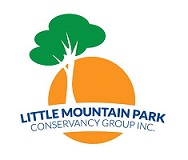Park History
Article Index
Park History
Real News Headlines
All Pages
Page 1 of 2
Over the years there have been many questions asked or not asked about the history of Little Mountain Park. More than 100 years ago, it was home to a village named Mount Royal ( the area is also known as Little Stony Mountain ) and a stone crushing operation which was the first limestone quarry of the city of Winnipeg.

northern Municipal pit
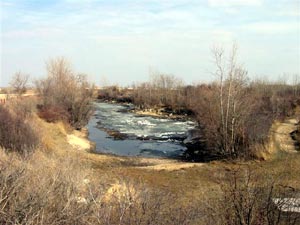
southern Egan pit
The Quarry's themselves (located between grid sections SW 1/4 Sec.34-Twp. 11-r.2 E and NW 1/4 Sec.26-Twp. 11-r.2 E) have names:
the Northern Quarry "Municipal" (or City) after the R.M.of Rosser and
the Southern Quarry (NE 27-11-2E) called "Egan," named after a contractor on the first stretch of the Winnipeg and Hudson Bay Railroad in 1886 known as "Sutherland's Forty ."
Mineral Inventory File No. 866
Product Dolomite, NTS Area 62H14NE, Ref. Dol 1
Name of Property / Little Stony Mountain ( Little Mountain)
Owner of Operator Address / ( Corporation of the City of Winnipeg)( Little Stony Mountain Quarry Co.)
Object Located Dolomite Quarries (2) / Mining Division Winnipeg
Latitude 49* 57' 40", Longitude 97* 14' 35" Uncertainty (m) 50m
Description of Deposit - Little Stony Mountain is a low ridge running north-south. The city of Winnipeg quarry is on the eastern side of the ridge, and the Egan quarry is a short distance farther south. The city quarry was sunk through 0.3-2.5m of overburden, 1.5-5m of finely crystalline dolomite of the Gunton Member and 1.2m of yellow mottled argillaceous dolomite of the Penitentiary Member of the Ordovician Stony Mountain Formation.
Chemical Properties: Ca C03: 49.09-55.87%,Mg C03:45.06-40.24%. For chemical analysis see Groudge (1944) and Wells (1905).
Uses: Crushed stone for street paving, curb stones, lime, dimension stone.
The first recorded use of the area was made by Rev. D.T. Jones, he was one of the early Protestant Ministers that served at the Red River Colony. In a Manitoba Historical Society essay by Harry Shave ( M.H.S. Transactions Series 3, Number 6, 1949-50 season ) he described the flood of 1826.
" The year 1826 was one of severe trail for the missionaries, and settlers. It was in the spring of that year that a disastrous flood occurred. The ice held firm until the end of April. Two days later the water rose and lifted the ice in a solid mass nine feet above its previous level. It continued to rise. the settlers fled to higher ground, leaving their belongings behind. some of the men obtained boats and removed some of their grain, furniture and cooking utensils. At Fort Garry, the Governor and his family fled to the upper story of their residence, the water having risen to a depth of ten feet in the buildings. They were later taken by boat to a place of refuge. the parsonage and upper church were flooded, and like the settlers, Mr. Jones, his staff and school boarders fled to higher ground. Many of the log houses were dashed to pieces and floated away. The places of refuge were Little and Big Stony Mountain, Bird's Hill and Silver Heights. In the early days of the flood the temperature was 5 degrees below freezing and rain, snow and sleet fell intermittently. The missionaries and settlers lived in tents on the various promontories during this state of confusion.
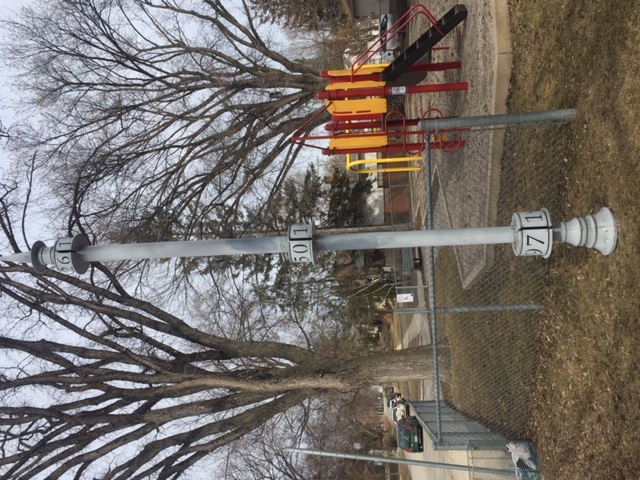
(Flood marker located on Scotia Street, look at the top of the pole)
Before leaving the church and parsonage, Mr. Jones and his staff had built a platform under the roof of the church, where they placed some of their furniture and other valuables. Another platform was erected above the water level in the church and on Sunday, May 14, the people went to Divine Service by boat.
When, on June 12, the water had subsided to the extent that the people could return to their homes, they found a scene of desolation. Only three houses in the whole settlement were left standing. One of these was the parsonage, but the partitions between the rooms, the doors, windows and furniture had all been swept away. The upper church building suffered little, but the lower was a shambles.
After the flood had subsided, the settlers busied themselves with the re-building of their homes and with seeding.
Although the settlers suffered severe losses, they seem to have taken the catastrophe philosophically and soon became re-established. Repairs were made to the churches and parsonage, and in a short time evidences of the flood had disappeared."
http://www.mhs.mb.ca/docs/ pageant/24/historicfloods. shtml
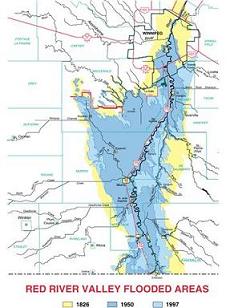
1850, the burning of Lime was undertaken on a fairly large scale. A railway spur was connected from Moore siding on the Canadian Pacific Railway ( about 1.5 km to the southwest) to the quarry site.
1855, Production of lime ceased about this year.
This area has been occupied since 1870, the first settlers, James Isbister, Neil and Duncan Livingstone had filed the original claim on the land. However in an article in the Manitoba Free Press January 11 1873 it was decided that,
"Persons settled on Stony Mountain will not be sustained in holding homesteads. The authorities hold that the Mountain being a Limestone quarry, comes under the head of mineral lands and is therefore reserved from settlement."
These people lost their acreage they filled on to that government decision.
The area was subdivided into small 5 to 20 acre lots and sold, "by Public competition ", On February 1 st the Federal Government stepped in and decided to put the Quarries on public market by public sale in 10 acre lots at $ 1.00 per acre. The whole section was owned by George Stephen, A. Nimmons owned W 27-11-2E and section 9-11-2E was farmland owned by Honorable James McKay.

According to the Manitoba Free Press on August 3, 1875,
"It was proposed to gravel the streets of Winnipeg. Mr. Nimmons of Little Stony Mountain can supply gravel."
In 1877, Mr. Nimmons offered to build a tramway to the city for delivery. On January 25, 1881 the Manitoba Free Press reported that,
"Mr. Nimmons sold his farm at Little Stony Mountain. 320 acres for $ 56,000. It lies three miles from city limits, including 40 acres of stone quarry, 20 acres of sand and gravel. W. Brydon and Peter Robinson, purchasers."
In 1896, The City of Winnipeg purchased 32 hectares of land from Lord Strathcona.
The business did survive a collapse in the Winnipeg market in 1886. In 1898 the production of crushed stone for road building and of stone curbing was begun. The curb stones were cut by hand in the quarry and, like the crushed stone, were hauled to the loading site by horse drawn wagons running on narrow gauge track.
In 1898 the City of Winnipeg opened its railway spur line to the quarry at section S 1/2 of SW 1/4 of 34-2E. The railway spur line cut through the land that was owned by the Egan family.
By 1900 the two quarries were in full operation, the Egan quarry and the City ( Municipal) quarry. The City quarry was the main producer of dimension and foundation stone as well as the crushed stone. Its size is 90m long by 45m wide. The oven can still be seen today.
1904 was the peak year of operation for the City quarry and the last year for the Egan quarries operation by the Little Stony Mountain Quarry Co.
In 1905, the City quarry was now 450m square and the increased thickness of the overburden as quarry size increased resulted in the operations becoming no longer profitable. The operation shut down and relocated to Stony Mountain .
The Park
Glacial Lake Agassiz formed a Limestone ridge that gave rise to the working quarries that in 1965 became what we know as Little Mountain Park . As reported in the Untied States Geological Survey of 1896.
" Little Stony Mountain. -- Eight miles south of Stony Mountain and 5 miles
west-northwest of Winnipeg, an outcrop of limestone, known as Little
Stony Mountain, has been quarried for lime-burning. The surface here rises
30 or 40 feet in a half mile, from east to west, to the limekiln and ( p.72 )
quarries, which are about 800 feet above the sea, and thence it holds nearly
this height westward. The limestone, shown to a depth of about 10 feet,
is apparently the same as that forming the upper part of Stony Mountain. It lies
in beds mostly 1 to 2 feet thick, horizontal, or in part dipping 1 to 2 degrees to
the south-southwest. "
The quarries, the Southern pit , Egan and the northern pit, Municipal, were after 10 years reopened in 1896 and the foundation for the village of Mount Royal was formed.
The village supplied the City of Winnipeg with it's first Limestone crushing operation. At it's height of production, 164 works and their families called the area home. But in 1905 the quarry was closed and the crusher was moved by horse drawn sled to present day Stony Mountain. Besides the two quarry's, the only reminder of the village of Mount Royal is the huge Cottonwood tree on Farmers road that was planted there many years ago.



- Haunted Manitoba
As a side note, rumor has it the the Cottonwood tree was also called the hanging tree or the KKK tree has three marks on one of the branches, I've found no evidence of anything happening there, people do get a cold chill when they are near it. So much so that the Winnipeg Paranormal Group has investigated the site and found some pretty interesting things around the Cottonwood and in the Quarry itself.
Little Mountain Park 07/02/08
" On our first trip to Little Mountain Park, we decided to focus the investigation on what is
referred to as the "KKK" tree. There are many reports of people being hung from this tree,
and reports of full bodied apparitions on or around said tree.
We took Video, photo, audio, and EMF readings. And while we did get a few small readings on
the EMF detector, our other evidence revealed nothing of interest.
For personal experiences, we did have some battery drainage on our video camera, and at
one point in the investigation, Glenn felt a hot spot on his hand. Peter felt Glenn's hand, and
immediately located the spot that was hotter than the rest of the hand.
Due to a lack of evidence, we cannot label the "KKK" tree as being haunted, but we definitely
would like to return and do another investigation of the tree".
Little Mountain Park 07/11/08
"We returned to Little Mountain park and focused our investigation on the pond/quarry this
time. Little Mountain Park was built on a limestone quarry, and it is believed that limestone acts
as a recorder for paranormal activity, resulting in a lot of residual haunting.
Once again, we documented our investigation with photos, video, audio, and EMF readings. We
didn't really turn up anything of interest except for a high pitch howling that I would attribute to local
wildlife, i.e. a bird. Other than that, we had no documented evidence of paranormal activity.
For personal experiences, there were few. Tatiana had moments of feeling extremely uncomfortable,
and Peter had a moment where a wave of panic came over him for about three seconds.
Overall, with the lack of evidence, we cannot label the park as haunted, but do plan to make a return trip."
" We took this picture as we were walking around, see if you can spot the face. It's center top,
behind the big rock formation.
We're not sure what to make of it, we will be taking a closer look at the spot on our night investigation.
It's probably just a great example of matrixing, but our return investigation should throw more light on it."
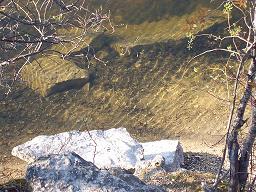
Up-date:
The week of May 05/10 the Paranormal group were back for another look at the area. The visit was mentioned by Joanne Kelly on April 26/10 Shaw Ch. 9, and covered by Marcy Markusa of the CBC.
In a book by Diane Steinback, 'How to Ghost Hunt in Winnipeg, Canada', she say's," Nighttime visitors have caught multiple orbs around the tree and people get an overwhelming sense of foreboding here".
Thursday July 22/2010, The Times pg. 16 , 'Ghost Hunters say the Truth is Out There' a story by Rob Brown, " St. Vital based husband and wife team of Fonzie and Sharon Granger are the driving spirits behind Shadows of Manitoba." Have been investigating Little Mountain's paranormal cases.
' Contrary to what some people might think, the Grangers say their investigative work is not about proving the paranormal, but disproving it'.
"When something is reported, we attempt to find a real world explanation for it," Sharon says.
* please take the time to read the full article.
All this makes for a really good ghost story at Halloween!
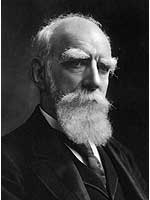
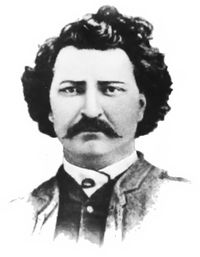
Donald A. Smith
Louis Riel
A letter found in the Manitoba archives by then Postmaster J.J. Taylor in 1906, made reference to the Post Office receiving its official name from Donald A. Smith, the Lord of Strathcona and Mount Royal. In 1869, he was charged with putting down the Riel Uprising. A military expedition from Eastern Canada under the direction of Colonel Garnet Wolseley had reached Fort Garry.
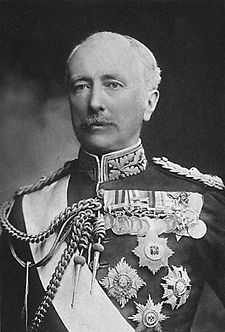
Garnet Wolseley
Louis Riel had fled to the United States and the uprising was halted. By 1872, Lord Strathcona had acquired much of the area, his home was located some three miles from the Post Office at Mount Royal.
The Quarry Village 1898 -1905
In 1896 the City of Winnipeg purchased 80 acres of property from Lord Strathcona for the development of Little Stony Mountain Quarry ( as it was called at that time ), under the direction of Colonel H.N. Ruttan. Here is a short biography of General Henry Norlande Ruttan ( 1848 - 1925 )
" Born in Cobourg, Ontario on 21 May 1848, son of Henry Jones and Margaret Ruttan, he was educated at Cobourg. He commenced a career in the engineering department of the Grand Trunk Railway ( 1866 to 1869 ), engineering staff of the Inter colonial ( 1869 to 1874 ), Canadian Pacific Railway ( 1874 to 1877 ), general practice of engineering ( 1877 to 1885 ), city Engineer, Winnipeg, since 1885. Served in No. 1 Company, 40th Battalion, during Fenian Raid, 1866. On formation of 90th Battalion, Winnipeg Rifles, was gazetted Captain of Company B. Served during North West Rebellion, 1885, under General Middleton. In command of 90th Battalion, 1895 - 1900, when was placed on list of Reserve Officers. On organization of 100th Regiment, Winnipeg Grenadiers, 1910, was gazetted to command. Married Andrina Barberie, Dalhousie, New Brunswick, 1882; has one daughter and four sons, including Arthur Charles Ruttan and Charles Millidge Ruttan. Society: AF & AM: Institute of Civil Engineers, London; American Society Civil Engineering, New York; Canadian Society Civil Engineering, of which he was President in 1910; Member Royal Society Arts and Manufacturing. Anglican. Address: Armstrong's Point, Winnipeg. Ruttan died on 13 October 1925, at Winnipeg" - Manitoba Historical Society
Colonel H.N. Ruttan did much of the engineering survey work for 12 of the city of Winnipeg well water supply's including a report to the U.S. Geological Survey;
" pg 579 - Rosser - The railway well at Rosser is 29 feet deep, in till, which forms the surface there and east to Little Stony Mountain; water rises 15 feet from a sandy layer at the bottom. "
The City of Winnipeg was using the crushed Limestone for it's development of it's streets at a price of $ 1.30 per cubic yard. Under the first superintendent, Mr. C.P. Kelpin the quarries went into full production and became the first municipally owed quarry in North America.
The unincorporated Village of Mount Royal laid claim to mayor, 2 blacksmith shops, post office, general store operated by Mr. L.P. Brault, a dance hall. A boarding house run by a Miss Ford, pool hall and of course, everybody's favorite person, the bootlegger (long,cold winters).
Unable to afford room and board many summer workers found shelter by excavating into the banks of the quarry. They used timbers and ties from the railroad line to make some kind of weather proof dwelling. The railway spur line connected to the present day Moore siding has long disappeared, some cleared sections of the stone bed still can be seen . The Municipal Pit, (north side of the road) owned by the R.M. of Rosser was reopened briefly during the 1930's to help local residents deal with employment during the Depression.
There are very few church records that have survived, the parish of Christ Church Rosser, was formed 13 May 1902 by Archbishop Robert Machray and had formally ceased to exist by 1952 when the church structure was removed from the site.
The 1906 Census of Canada for Manitoba, District #8 ( Selkirk), Sub district #17
Lists the following people at the Post Office of Mount Royal:
Pg. Row Hse. Surname Name Rel. Sex M. Status Age B. Place Immig. Year Post Office Sec/ward Twp/ Street Reg/No. Mer.
64 9 Kennedy Robt. S. M. S. 27 Irl. 1906 Mount Royal 4 12 2 E.
64 10 399 Comrie James H. M. M. 60 On. Mount Royal
64 11 Comrie Elizabeth W. F. M. 50 On. Mount Royal
64 12 Comrie Robert S. M. S. 22 On. Mount Royal
64 13 Comrie Jessie D. F. S. 19 On. Mount Royal
64 14 Comrie George S. M. S. 17 On. Mount Royal
64 15 Comrie James S. M. S. 15 On. Mount Royal
64 16 Comrie Harriet D. F. S. 12 On. Mount Royal
64 17 400 Lawrence James H. M. M. 77 Sct. 1873 Mount Royal 4 12 2 E.
64 18 Lawrence Margaret W. F. M. 73 Sct. 1873 Mount Royal
64 19 Lawrence Lyle S. M. S. 46 Sct. 1873 Mount Royal
64 20 Lawrence Nellie D. F. S. 30 On. Mount Royal
64 21 Lawrence Edward S. M. S. 26 Mb. Mount Royal
64 22 Clement John Hir. M. S. 35 Eng. 1906 Mount Royal
Records have shown that according to the Fort Garry Horse Museum ,the people of the village of Mount Royal (Little Stony Mountain) have also seen military action. As early as 1876 the area around Little Stony Mountain was being used as a training ground for the 13th Winnipeg Field Battery. The camp was in service during the summer months up to 1903, some troops that trained there may have seen service in the Boer War in Africa and the First World War.

In an article by W.L. Marschamps, Massey's Magazine March 1897 vol. 3 pgs. 183-192 , he chronicles the development of the Field Battery. It is very interesting reading. This is a 'VERY' short synopsis of the article.
" The 13th, or "Winnipeg" Field Battery of Canadian Artillery was organized in 1871 at the request of a number of loyal citizens of old 'Fort Garry', with a view to training in the science of gunnery, a specially selected number of the residents of the Red River Settlement favourable to Canadian connection as an additional aid towards the preservation of the peace, order, and good government of the recently-established Province of Manitoba, now known as the "Bull's Eye" of the Dominion, then the recent scene of stirring events in the history of the country which had left that new community in a condition which made all law-abiding inhabitants apprehensive of the public safety."
* more to come!
Many thanks to Lara Andrews , Librarian at the Military History Research Centre Canadian War Museum in Ottawa.
I have found railways spikes, square nails, .45 and .22 bullets
The Post Office (1906 - 1920)
The Post Office was opened in 1902 and remained open until 1920, situated in the general store (Owen by Mr.L.P. Brault). He was payed a sum of $ 34.00 a year for the use of the space in his store. Being the Postmaster was quite an honor and a seat on the council, however it was the housewives job to make the run to Winnipeg three times a week to pick up and drop off the mail. A frontier town was not known for it's neatness so there was an endless track of muddy floors that needed to be cleaned. The post office remain on site from 1906 to 1918 when it moved to Stony Mountain.
During the First World War the railroad employed many foreign works, it was the responsibility of the post office to stamp their identification cards. It was not uncommon to have twenty or more at a time crammed into the small store.
The School
During the height of production the number of school children swelled to 25. This proved to be to much for the small Mount Royal school to handle. Acting on a suggestion by Mr. W. MacWilliam, the children were moved into the dance hall in the village. The raised stage became the class room for the small community.
Name: Little Mountain School District #52
Location: NE 21-11-2 EPM
Formation Date & Device: March 7, 1878 under the device of the Protestant Board of Education
Reorganized Date & Detail: January 1, 1958 into the Municipality of Rosser School District #2356
Historic Sites of Manitoba: Little Mountain School No. 52 (Klimpke Road, RM of Rosser)
Link to:
Photos & Coordinates | Sources
The Little Mountain School District was established formally in March 1878. A one-room schoolhouse operated at NE21-11-2E in what would later be the Rural Municipality of Rosser. The original structure was relocated to the farm of school district trustee Hiram Ridge where it was converted into a family residence, later burning in a house fire. A second school building was constructed in 1902, at what is now the southwest corner of Klimpke Road and the old Inkster Boulevard (prior to the construction of CentrePort Canada Way). It sustained fire damage on 24 May 1948 but was saved, although on-site school records were lost in the blaze. The school re-opened and, in January 1958, the district became part of the Rosser Municipal School District. The school was closed on 30 June 1964. In 1971, the building and property was sold for $5,050, after which the building was used as a barn. At the time of a site visit in September 2018, it stood vacant but was in poor structural condition. It was demolished on 16 July 2020.
Among the teachers who worked at Little Mountain School through the years were Sam Newton, Thomas Beveridge (1884, 1888, 1889), A. C. Shafer (1885), Harriet Thompson (1886-1887), M? E. O’Brien (1889), Sarah J. Rankin (1889-1890), Ida M. Bond (1890), Clara Buist (1891), R. S. Marur (1891), Martha D? Christie (1892), Annie E. Fraser (1892-1894), A. W? Colfitts (1895), Charles Hickson (1895-1897), William L. MacKenzie (1898-1899), John Sawford Peach (1900), John R. English (1901), ? (1902-1904), Esther Lion (1905), Maud [Maude] Emes (1905-1907), Mary M. Thompson (1908-1909), Estelle P. Cromwell (1910), A. Edna Pope (1911, 1911-1913), L. C. Anderson (1911), A. Cameron (1913), Edna Huntley (1914, 1915), Marion A. Buckley (1915, 1916), Josephine Dumas (1915), J. A. McCullough (1915), Olive Rae (1916), Marion A. Buckley (1916), Helen M. McKelvy (1917-1918), Alma M. Kellington (1918-1919), Annie Cameron (1919-1921), Rachel I. Hill (1921), John Bruce Day (1922), Guy B. Stevens (1923), Hubert Harry Hooper (1923-1925), Robert Holloway (1925-1926), Ronald Victor Shearer (1927-1929), Walter William Mark (1929-1930), Muriel E. Paterson (1930-1935), Margaret Isabelle Morrison (1935-1939), Mary McIntyre Cummings (1939-1942), Alice Lawrence (1942-1943), Tena Siemens (1943-1944), Jeanette B. Gustafson Chimuk (1944-1946), Elizabeth D. Parr (1946-1947), Phyllis Irene Allinson Olson (1947-1949), Jean Bertha Rudy Gilson (1949-1951), Ivadell Doreen Bothwell Telford (1952-1955), Ruby Matwichuk Putaro (1955-1956), Justine Harriet McArthur (1956-1958), Lynne Murphy Solar (1958-1960), Elaine Margaret Georgine Elliott (1960-1961), and Jemima Florence Webster (1961-1964).
Many thanks to the Manitoba Historical Society for the information on this.

The School District Of Little Mountain No. 52
Cross-Reference:
By-Law No. 1141 of R.M. of Rosser, dated May 7,1957 and effective January 1st,1958, forming The Municipal School District of Rosser No.2356 and including all lands comprising the following school districts:
Little Mountain S.D. No. 52 (union)
Lillyfield S. D. No. 226
Rosser S.D. No. 594
Rosser Village S, D. No. 750
Gerrie S.D. No. 778
West Rosser S. D. No. 1246
Meadows S.D. No. 1365
Wentworth S.D. No. 1801
Kelsey S. D. No. 2318
will be found in The Municipal School District of Rosser No. 2356 formation file.
Reorganized Date & Detail: January 4 1967, into the Interlake School Division #21
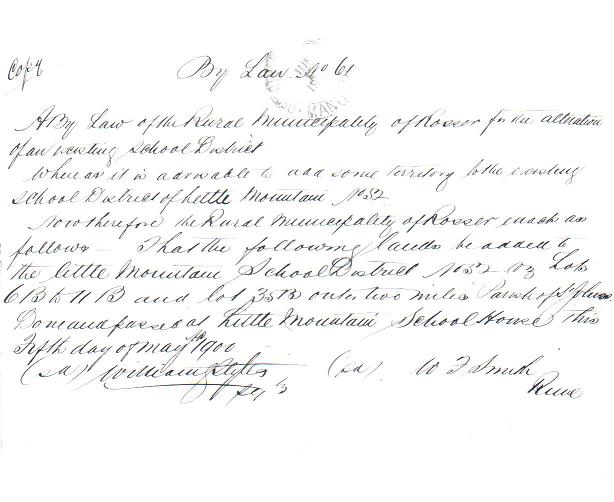

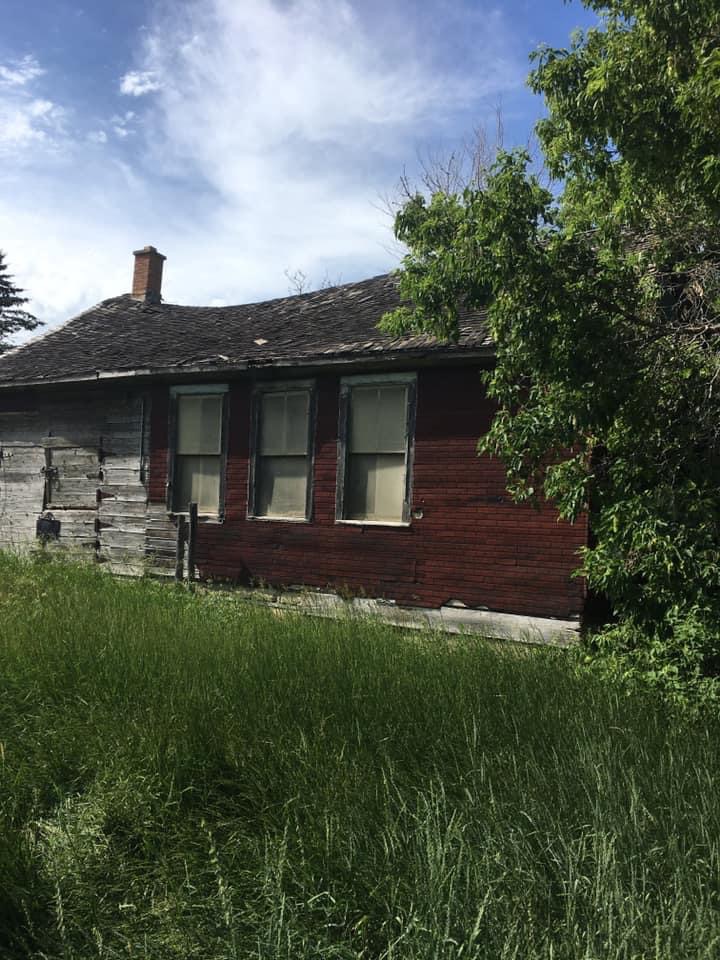
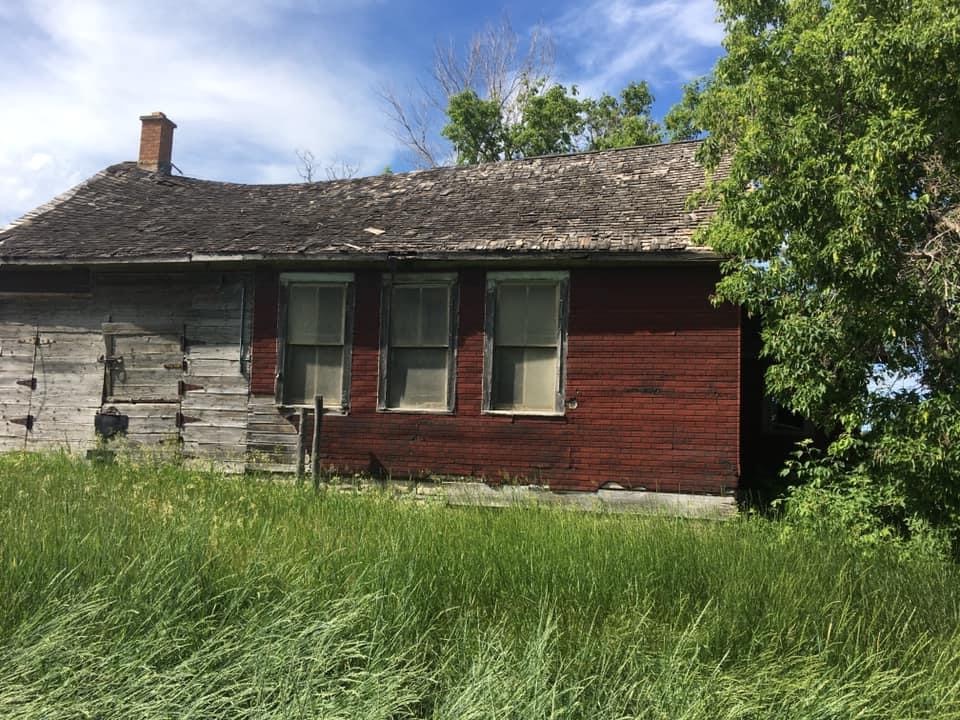
Recently uncovered founation stones from the schoolhouse or post office.
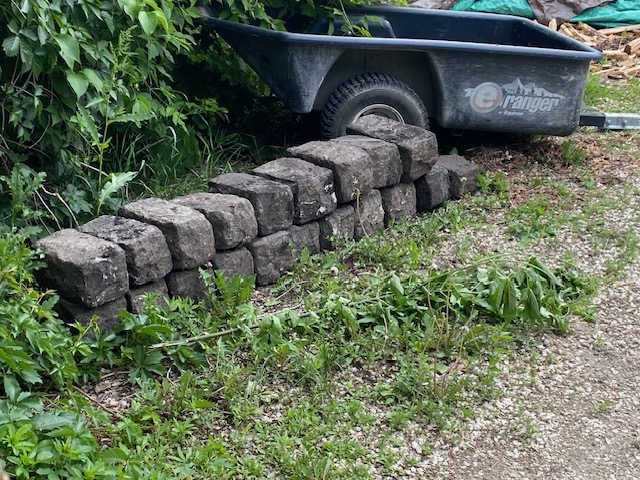
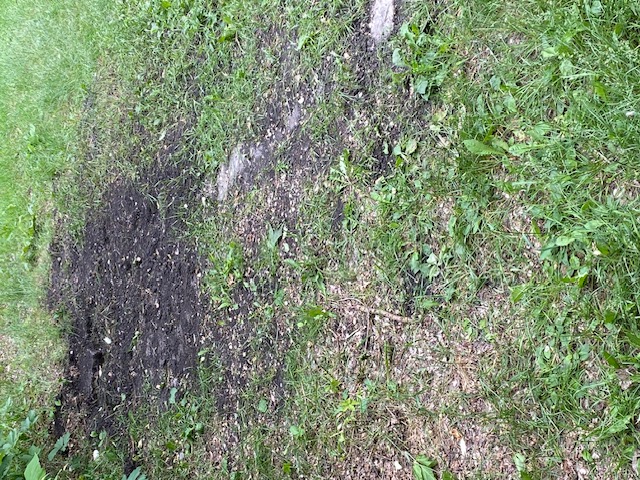
(photo's courtesy of Ted Ash)
Historic Sites of Manitoba: Little Mountain School No. 52...
www.mhs.mb.ca/docs/sites/littlemountainschool.shtml
A second school building was constructed in 1902, at what is now the southwest corner of Klimpke Road and the old Inkster Boulevard (prior to the construction of CentrePort Canada Way). It sustained fire damage on 24 May 1948 but was saved, although on-site school records were lost in the blaze.
Manitoba Free Press October 17, 1903 ( * there's a few words in the article I couldn't make out , sorry )
Grant for Quarry School
Education Difficulty there has largely Solved at Last:
The refusal or objection of the Rosser Municipality to give school facilities to the children residing at the city quarries was the only change from the usual routine of business at the finance committee meeting yesterday. Foreman Kelpin wrote as follows:
" About a year ago there were twelve children whose parents were employees of the city quarry, attending daily at Little Mountain School. They were nearly all notified that their parents must pay a monthly fee for each pupil or they could not attend any longer. Some of the pupils were given the money, which they paid over to the teacher for the trustees. This, I contended was illegal, as the parents were tenants on the quarry property for which the city was paying school taxes. One man, Mr. John Hutchinson refused to send the money asked for, and his children were refused admittance to the school. I, in company with Mr. Hutchinson, called on Mr. Moore, chairman of the board of trustees and told him if they did not allow the children to attend school, we would enter action for damages. This had the desired effect and the children were permitted to attend school. I was told after that, the money collected had been returned to the pupils. Ever since that time the quarry men children were merely allowed in the school on suffrage ."
" Owing to the condition of affairs in the Little Mountain School, we decided to open a school in the hall at the quarry. We petitioned the municipality of Rosser to put aside some territory that we might get a grant from the Provincial government , but the arbitrators appointed by the municipality refused the application. The government, however on the recommendation of Inspector Best, allowed us the usual grant given to Public schools. The school was opened on Monday, October 5, with sixteen children in attendance."
" The distance from the quarry to Little Mountain School is one and a quarter miles. The school at that place that 46 pupils of which 19 were from the quarry. We have room for 24 children. Outside of $ 130 from the government the expense is met by voluntary subscription."
City Gives Grant
Chairman Russell frankly stated his objection of teachers who would accept given instructions as to merely have the children in the school on suffrage. Such were not fit to be teachers. Ald. Gibson did not think it was the teacher who was to blame. The responsible people are the trustees. Ald. Wead who ladulged in expressing some very decided opinions on the matter. The establishing of the school, however and its recognition by the local government had to a very great extent survived the difficulty, and the committee decided to recommend the grant of $ 130 towards its maintenance. The city solution in answer to a query as to the constitutionality of such an act saw teaching to the contrary.
The lots on the Northwest corner of William Avenue and Kate street, with a frontage of ( ? ) feet on William and a depth of 132 feet to a lane, did not attract many bids. After being advertised several times only two offers were made, one at $ 2,100 and another at $ 1,508. These were not favorably received and were referred to the committee did not feel disposed to part with the land. It was central, Ald. Russell pointed out and could be used for quarry public purposes and if they ( ?) to buy such a piece they would (?) to pay a big price for it. The city owns considerable lands and bids will be taken to dispose of such as are not likely to be useful to the city.
A(?) dan sent up the board of works as approved by them, being a subdivision of D.G.S. G2 St. James was approved by the finance committee. Other subdivision plans were also approved.
Next
Details
Published: 06 April 2008
Last Updated: 05 April 2021
Hits: 54200
Who's Online
We have 143 guests and one member online
Copyright © 2021 Little Mountain Park Pet Owners Assoc. All Rights Reserved.
Joomla! is Free Software released under the GNU General Public License.
Back to Top
© 2021 Little Mountain Park Pet Owners Assoc
